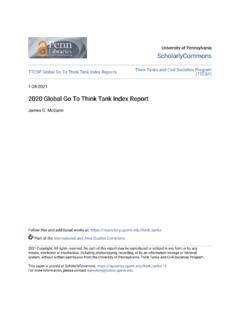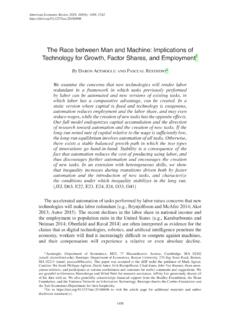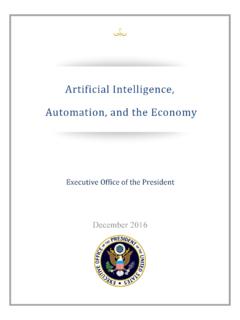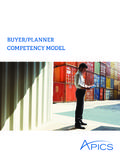Transcription of THE IMPACT OF ARTIFICIAL INTELLIGENCE ON EMPLOYMENT
1 119 Technological development, and in particular digitalisation, has major implications for labour markets. Assessing its IMPACT will be crucial for developing policies that promote efficient labour markets for the benefit of workers, employers and societies as a technological progress and innovation can threaten employ-ment. Such a concern is not new but dates back at least to the 1930s, when John Maynard Keynes postulated his technological unemployment theory technological change causes loss of jobs (Keynes 1937).Technological innovations can affect EMPLOYMENT in two main ways: by directly displacing workers from tasks they were previously performing (displacement effect) by increasing the demand for labour in industries or jobs that arise or develop due to technological progress (productivity effect).
2 Autor, Levy and Murnane (2003) stress that technology can replace human labour in routine tasks , whether manual or cognitive, but (as yet) cannot replace human labour in non-routine tasks . Goos THE IMPACT OF ARTIFICIAL INTELLIGENCE ON EMPLOYMENTG eorgios Petropoulos1120 GEORGIOS PETROPOULOSand Manning (2007) argue that the IMPACT of technology leads to ris-ing relative demand in well-paid skilled jobs, which typically require non-routine cognitive skills, and rising relative demand in low-paid, least-skilled jobs, which typically require non-routine manual the same time, demand for middling jobs, which have typically required routine manual and cognitive skills, will fall. The authors call this process job polarisation. Acemoglu and Autor (2011) found similar results for the US, while Darvas and Wolff (2016) report such developments for a selection of EU countries: France, Germany, Italy, Spain, Sweden and the UK.
3 In all these countries, the number of high-education jobs such as managers, engineers and health professionals is growing, while the number of middle-education jobs (clerks, machine operators, assemblers) is declining. By contrast, the number of low-education service occupa-tions, such as shop workers, which are non-standard and difficult to replace by automation, is growing. A key conclusion is that technol-ogy was incorporated into the subset of core job tasks previously performed by middle-skill workers, causing substantial change. The quality of human capital also plays a crucial role. The ability of individuals to use the technological advances for the benefit of their work requires developing particular digital skills through well-designed policies. This underlines the importance of using appropri-ate instruments to ensure that workers are well prepared to harness the disruptive forces of digital the last decade platforms emerged that contributed to increased connectivity between individuals.
4 For example, using this connec-tivity, peer providers of durable goods and services can trade online with individuals using collaborative economy platforms. A key common characteristic of collaborative economy models despite a great deal of variety is that they provide an economic opportunity for individuals and small enterprises to trade their under-used assets with other individuals through intermediaries that match supply and demand in an efficient way with the help of information technolo-gies. In many cases, this opportunity to individual suppliers is only provided through collaborative platforms, as the supply of goods 121 THE IMPACT OF ARTIFICIAL INTELLIGENCE ON EMPLOYMENTand services through other channels is subject to licensing and other regulatory barriers. Automation in shopping through ecommerce is another example, with the sector experiencing annual growth of 22% in The benefits of information technologies increase demand for online retail goods and this in turn leads to an increased overall EMPLOYMENT in , looking ahead, a new wave of automation and advanced machine-learning techniques is on its way, in which intelligent machines will be increasingly capable of carrying out high-skill and possibly non-routine tasks .
5 Moving from the efficiency gains in online trading to the extensive use of ARTIFICIAL intelligent systems in our industrial production, concerns about the potential displacement of labour emerge. The real question then becomes: which of the two labour market effects displacement or productivity will dominate in the ARTIFICIAL INTELLIGENCE (AI) era?3A first approach to answer this question is to examine the IMPACT of technological breakthroughs on labour markets in previ-ous industrial revolutions (Soete this volume). For example, the introduction of automobiles in daily life led to a decline in horse-related jobs, but new industries also emerged, with a net positive IMPACT on EMPLOYMENT . The automobile industry itself grew fast, creating many new jobs, but other sectors also grew because of the growing number of vehicles on the roads, and many new jobs in the motel and fast-food industries arose to serve motorists and truck Economist (2016) reports further case studies that show simi-lar patterns.
6 In general, past industrial revolutions suggest that in the short run the displacement effect may dominate. But in the longer run, when markets and society are fully adapted to major automa-tion shocks, the productivity effect can dominate and have a positive IMPACT on how reliable is this approach? Researchers from the McKinsey Global Institute estimate that the disruption of society caused by AI is happening 10 times faster and at 300 times the scale of the industrial revolution of the late 18th and early 19th centuries, and is 122 GEORGIOS PETROPOULOS therefore having roughly 3,000 times the IMPACT (Dobbs, Manyika and Woetzel 2015).Moreover, the main engine of technological progress in the AI era is the continuous development of deep machine-learning techniques that use the function and complexity of the human brain as a model for design (see Petropoulos 2017b); for relevant definitions and analysis see Box 1.
7 Machines are trained to be intelligent, which can have additional implications for the 1. AN INTRODUCTION TO MACHINE LEARNINGM achine learning enables computer programs to acquire knowl-edge and skills, and even improve their own performance. Big data provides the raw material for machine learning, and offers examples that computer programs can use for practise in order to learn, exercise and ultimately perform their assigned tasks more idea of intelligent machines arose in the early 20th century. From the beginning, the idea of human-like INTELLIGENCE was key. Following Vannevar Bush s seminal work from 1945, where he proposed a system which amplifies people s own knowledge and understanding , Alan Turing asked Can a machine think? In his famous 1950 imitation game, Turing proposed a test of a machine s ability to exhibit intelligent behaviour equivalent to that of a principle, machine learning follows Turing s recommenda-tion of teaching a machine to perform specific tasks as if it were a child.
8 By building a machine with sufficient computational resources, offering training examples from real world data and by designing specific algorithms and tools that define a learning process, rather than specific data manipulations, machines can improve their performance through learning by doing, inferring patterns and checking hypotheses. 123 THE IMPACT OF ARTIFICIAL INTELLIGENCE ON EMPLOYMENTAt the core of this learning process are ARTIFICIAL neural net-works, inspired by the networks of neurons in the human brain. A simple ARTIFICIAL neural network is organised in layers. Data is introduced to the network through an input layer. Then come the hidden multiple layers in which information is processed and finally an output layer where results are released. Each neuron within the network is connected to many others, as both inputs and outputs, but the connections are not equal.
9 They are weighted such that a neuron s different outward connections fire at differ-ent levels of input activation. A network with many hidden layers can combine, sort or divide signals by applying different weights to them and passing the result to the next layer. The number of hidden layers demonstrates the ability of the network to detect increasingly subtle features of the input data. The training of the network takes place by adjusting neurons connection weights, so that the network gives the desired response when presented with particular goal of the neural network is to solve problems in the same way that a hypothesised human brain would, albeit without any conscious codified awareness of the rules and patterns that have been inferred from the data. Modern neural network projects typi-cally work with a few thousand to a few million neural units and millions of connections.
10 They are called deep because of the mul-tiple intermediate hidden layers they have. However, deep neural networks are still several orders of magnitude less complex than the human brain and closer to the computing power of a neural networks have proven very effective. There are several examples of games and competitions in which machines can now beat humans. By now, machines have topped the best humans at most games traditionally held up as measures of human intellect, including chess (recall for example the 1997 game between IBM s Deep Blue and the champion Garry Kasparov), Scrabble, Othello and Jeopardy! Even in more complex games, machines seem to be quickly improving their performance through their learning process. In March 2016, the AlphaGo 124 GEORGIOS PETROPOULOS computer program from the AI start up DeepMind beat Lee Sedol at a five-game match of Go the oldest board game, invented in China more than 2,500 years ago.









